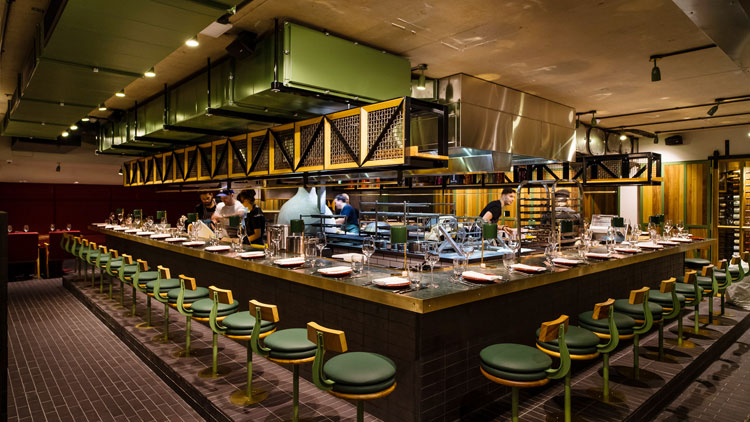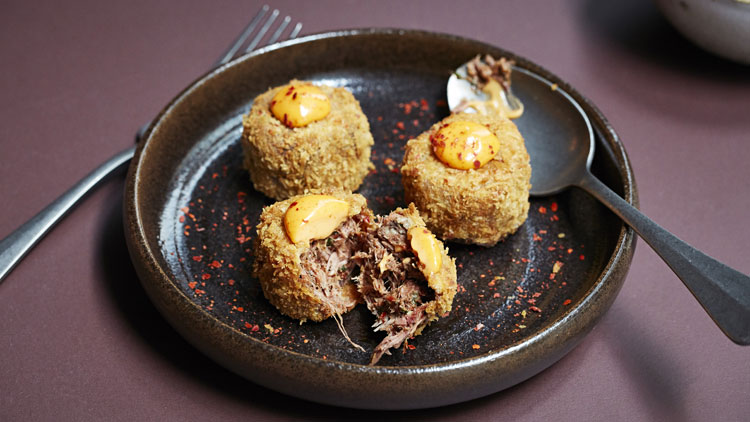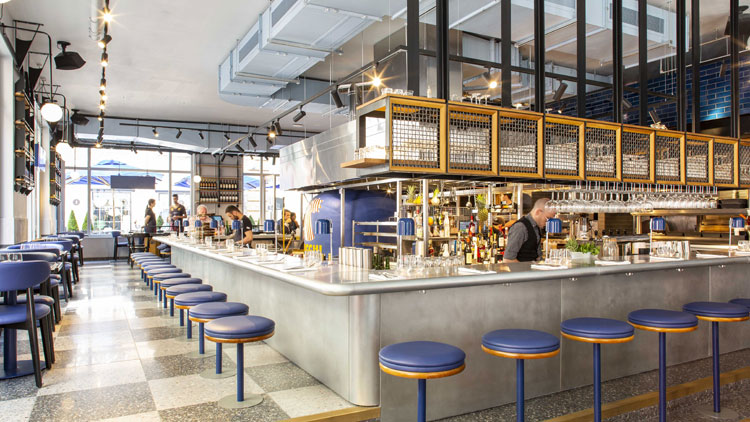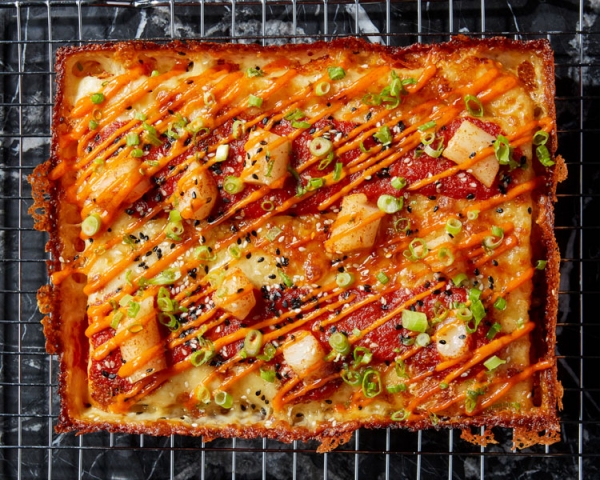Business profile
Temper turns two: What's next for the restaurant group?

Sam Lee, managing director of restaurant group Temper, describes chef and business partner Neil Rankin as “the little brother I never wanted”. The sibling metaphor is fitting given the way the pair interact during our interview – happily ribbing the other’s various ‘faults’. Rankin, beneath the tough tattooed and trucker cap-wearing exterior is a Michael Bublé and Love Island fan, Lee tells me with glee (she’s more of an AC/DC fan herself ), followed by a cheeky return salvo from the chef: “We have rows. I let her go on until she thinks she’s won.” So no Temper tantrums then.
The incident over last year’s Christmas decorations at the group’s first restaurant, Temper in Soho, is a case in point. Lee spent a lot of effort putting them up only for Rankin to pull them down when she wasn’t around, and for the process to then be repeated. “It turned into a competition of who could piss each other off the most,” recalls Rankin.
This might not seem to be the most conventional of business partnerships but beyond the squabbling siblings act, Leeand Rankin make a surprisingly formidable pair. Both, they say, bring something different to the three-strong restaurant business, and are happy to leave each other to it. “I’d like to see how Neil gets on with a 420-page lease,” says Lee.
“But for him to ask me to whip up a new dish for the menu, toad in the hole would be what you’d get. We have our own skills.” Temper isn’t a conventional business, either. While its three Imbiba-backed restaurants sit under the same Temper banner, each has its own identity and serves different cuisine. Temper Soho is a barbecue spot with a South American influence that majors on tacos, flat breads and mezcal, while Temper City serves barbecue meats alongside curries and gin. By even greater contrast, the group’s third restaurant, in Covent Garden, focuses on cured meats and US-style pizzas.
A multifaceted brand
So why have three distinct offerings under one uniting brand, especially given that Temper Soho has proven to be such a success?
“Soho works really well,” says Rankin. “But to do that exact menu elsewhere would get boring very quickly. I don’t think the investment is there for restaurants that want to roll out with the same thing. If Jamie Oliver had modified his brand over time and been a bit more creative, would he be in the position he is now? I don’t know."
Although each restaurant’s offer is different, there is a guiding rationale behind them, with Rankin, a former head chef at barbecue restaurant Pitt Cue, placing his trademark whole animal butchery at their core. A live fire kitchen with hanging joints of meat is a feature at both the Soho and City restaurants, although not at Covent Garden, and counter dining is key at all three.
“The Temper bit for me is about assurance,” says Lee. “We’re not really casual dining, we’ve spent £1.6m on sites, but we’re not high-end either. The Temper name says that you get the vibe and counter dining, but each restaurant is a little different. When you’ve got two restaurants this is hard to convey, but now we’ve got three and when we get a fourth it will become clearer to people.”
“The idea is to have a central hub of meat for whole animal butchery, which is what we do. But you don’t get that in Covent Garden,” admits Rankin. “You don’t get that we’ve been butchering goats and cows and sending them off to be cured for six months. Temper Soho uses prime cuts and the idea behind the curry restaurant was to use the off cuts for braising. The pizza restaurant uses cured meats from the legs, but it’s not easy to translate that to a customer without shoving it down their throat.
“The concept is clear in my head but translating that to the customer [at Covent Garden] doesn’t work.”
The Soho stalwart
Temper Soho is seen as the hero concept, and one that is likely to inform future restaurants as the company continues to grow (more on that later). And yet the model that has proven so popular wasn’t the original intention of Rankin when he decided to do his own restaurant concept.
Having launched Smokehouse restaurants as executive chef for Noble Inns, and then all-day diner Bad Egg in London’s Moorgate, Rankin had initially intended to convey his love of the grill in a Barrafina-esque-style restaurant, with a two-storey site on Soho’s Denman Street – now home to Indian restaurant group Kricket – his target site. The idea was to create a small wine bar downstairs with counter dining on the ground floor.
“I like Barrafina and The Palomar,” he says. “You can smell the grill and see the food being made, there’s that closeness with the customer. That’s what’s made Kiln (in Soho) and Barrafina good and what Denman Street would have been perfect for.”
Looking to fund the restaurant with a single investor, Rankin got spooked during the bidding process and eventually backed out of the partnership. Shaftesbury, which was marketing the site, was keen for him to pursue it, and put him in touch with a number of other investors. He met with Imbiba, a specialist in the UK leisure and hospitality market, and the group invested under its Leisure EIS Fund.
Rankin initially came to Imbiba with four concepts, including one called Big Worm, a smoked meat taco and tequila joint based on Valentina’s Tex Mex BBQ in Austin, Texas. Imbiba, however, had other ideas, with the Temper brand its preferred choice, but for it to be more high-end and in larger locations than the Denman Street site. Settling on a large split-level site in Soho, the original Barrafina-style approach was shelved with Temper instead retaining Rankin’s smoked meat and taco angle but in a more upscale setting.
“I had a menu of very simple food, the likes of which you see at Barrafina or Brat (in Shoreditch), but I was faced with 4,500sq ft in the middle of Soho with a basement and I’m thinking ‘shit this doesn’t really work’,” he recalls. “Even Barrafina wouldn’t work there. So we had to do something slightly high-end but still casual to appeal to a larger number of people.”
Another reason for the larger site, and thus a change of the original concept, was down to the vagaries of being governed by an EIS fund, which offers investors a number of tax reliefs. The group had raised a pot of cash through high net-worth investors, and that money had to be spent, meaning they had to aim bigger than first planned. “With the amount of investment we got, and in the time that we had to spend the money, we’d have had to have done about five [Denman Street] restaurants,” says Lee. “You’re in a bizarre situation where you have to spend the money.”
With Soho came Lee, following Imbiba’s practice of bringing in a managing director to its businesses. Lee, who got the job after no fewer than seven interviews, describes herself as a ‘straightforward northern person’. Having spent 16 years in pubs, (“some more salubrious than others”) and held roles including operations director at Searcys and CEO at Scarlet Events, her interest in food and drink put her in good stead.
“The appeal was that I’m not a chef but I have an interest in food and wine from a layman’s perspective,” she says, proudly adding that Rankin had recently been impressed by pictures of her barbecue.
“One thing that works brilliantly is that we don’t overlap. I’m not an emotional person at all. Give me a menu and my first questions are about supply chain, GP and pricing. Neil brings the emotion and passion into the food, I bring the reality about what will keep us profitable and allow us to pay people’s wages. In the end, we get something right for the brand and for the business.”
City Changes
Rankin’s fear of duplication has thus far proven both a blessing and a curse. Temper’s second site, in the City at the Angel Court development, has so far failed to live up to the success of Soho, and this is partly down to its curry proposition.
While Rankin says it was “probably too early to put a place in the City”, the pair freely admit their disinclination to launch another taco restaurant was a misstep.
“As a second site, it was a good decision on paper but it looked a bit of a corporate move, which reflected on us. At lunchtimes, with the curry menu, we have struggled. We’re the opposite to everyone else in the City, we’re OK in the evenings but curry for city workers at lunch is quite a hard stretch.
“With City, if you’ve got 10 people dining, and Bob from accounts doesn’t like curry, they’re not going to go there. We need a more populist menu.”
This is where having the same branding across the sites has worked as it has brought some flex to the business. Following a ‘Temper referendum’, the company is currently in the throes of modifying City to follow the Soho model, ditching curry in favour of tacos but making it a bit more all-day-focused with an expanded tostada menu, something it can do with relative ease.
“This will be Temper Soho on steroids,” says Rankin.
Covent Garden has thrown up different challenges. Here average spend per head is lower – the company aims for £35 to £40 per head for dinner – and the investors are getting twitchy. Unwilling to increase the price of the pizzas – its round thin pizzas range from £9 to £16.50 and its Detroit square pizzas are either £14 or £28 depending on the size – Rankin has had to create additional menu items to encourage spend.
Tough environment
There are other barriers to trade that Rankin and Lee are vocal about, and which don’t just pertain to Temper. Their biggest bugbear is with the current trading environment in the capital – not with the oft-mentioned high rents and business rates but instead with what Rankin describes as the “suffocating restrictions” of the local councils.
Current drinks licensing means customers at Covent Garden have to order food to be able to drink – during Wimbledon fortnight it had to turn away drinks trade from those watching the tennis in an alfresco viewing area immediately outside the restaurant.
Despite being located in one of the busiest areas of one of the largest capital cities in the world, the latest it can open is midnight, on a Friday and Saturday, thanks to rules set down by local residents.
“We are really restricted by the residents, they even take pictures of our doors and email us about our licence,” says Lee. “Every time I get on a plane back to the UK, there’s some magazine article telling me how progressive London is and I read it and think ‘that’s a load of crap’.
Rankin shares her disdain. “There are 10 million people in London, enough to fill its restaurants. But we’re having to appease residents and foreign investors. It’s a fucking capital city, it needs to be a bit more progressive. In New York you can eat and drink whenever you want. And then these high rents won’t seem that ridiculous anymore, because at the moment they kind of do.”
The pair had intended to do delivery out of Covent Garden, but this was also scuppered by the local residents – although it has reapplied for a licence. “To ignore delivery is like a retailer ignoring internet shopping 10 years ago,” says Rankin. “People like JKS have done it really well [with its Motu brand]. They are smart by creating a business out of it.” It is for this reason that Rankin sees the City as the next proper restaurant hub.
“The restrictions in central London that are suffocating us do not exist in the City. Even in Shoreditch you can’t get late licences. Once Londoners get over their ‘I don’t go to the City to eat’ thing it will become a bit more like New York.” Add in the comparatively cheap rents – Temper pays around £300,000 in rent at its Covent Garden and Soho sites and £100,000 less in the City, even though it is a bigger site and is open later – and the attraction become even clearer.
“In five or six years’ time, the City will be the place every restaurateur wants to be. It’s the only place you can get an A4 licence, the only place with any fucking space, and no residents – so you can do what the hell you want.”
Future blueprint
What of Temper’s future? With its Temper Soho model about to come to the City, Covent Garden and its pizza offer looks to be even more out on a limb. With this in mind, there may be a tweak in the branding to add a strapline to the restaurant to help differentiate it from the others.
The curry concept could also be resuscitated but in a more suitable location, most likely Soho. Lee and Rankin regard Soho as being where Temper thrives, but acknowledge the area couldn’t support a second taco iteration. Depending on its location, Temper four could even see Rankin return to his original idea with a smaller wine bar operation.
“The next one will be right for the location,” says Lee. “We’ve got to be more specific about what we want. The panic now is over in terms of property – more stuff is coming back to the market and there’s massive wriggle room now.”
Aside from Soho, other target areas include Fitzrovia, Shoreditch and even Mayfair – they looked at the site that became Sabor but it was turned down by the board, which is still a sore point. Canary Wharf is favoured by Rankin, but is an unlikely location. “We all have to agree on the sites, which is why we are yet to venture to Canary Wharf because one member of the board can’t get their head around it,” says Lee.
What is most likely is that the Soho model of barbecued meats, tacos and flat breads will become the shorthand for the Temper brand, although the pair are adamant they aren’t just going to simply replicate it elsewhere. “There will be more Temper Sohos – the success of that needs to be duplicated somehow,” says Lee.
“But you’ll never see a cookie cutter approach,” interjects Rankin. “Soho has got Thai, Indian and Vietnamese influence and this could be a bit more closely related in future ones. And we’ll definitely do slightly smaller sites from now on; 110 to 140 covers is our sweet spot (Covent Garden has 146, Soho 193, City 249).
Does this mean we’re going to see a more conventional restaurant rollout from the pair going forwards? Possibly. But with these two, a curve ball is only a throw away. As Lee says: “I do struggle being told what to do. We both do.”
This feature first appeared in the August 2018 issue of Restaurant magazine, the leading title for the UK's restaurant industry. For more features, comment, interviews and in-depth analysis of the sector subscribe to Restaurant magazine here.



































